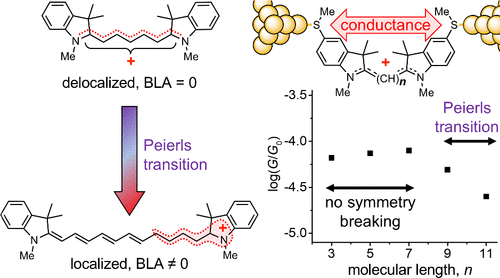当前位置:
X-MOL 学术
›
J. Am. Chem. Soc.
›
论文详情
Our official English website, www.x-mol.net, welcomes your
feedback! (Note: you will need to create a separate account there.)
A Peierls Transition in Long Polymethine Molecular Wires: Evolution of Molecular Geometry and Single-Molecule Conductance
Journal of the American Chemical Society ( IF 14.4 ) Pub Date : 2021-11-24 , DOI: 10.1021/jacs.1c10747 Wenjun Xu 1 , Edmund Leary 2 , Sara Sangtarash 3 , Michael Jirasek 1 , M Teresa González 2 , Kirsten E Christensen 1 , Lydia Abellán Vicente 2 , Nicolás Agraït 2, 4 , Simon J Higgins 5 , Richard J Nichols 5 , Colin J Lambert 6 , Harry L Anderson 1
Journal of the American Chemical Society ( IF 14.4 ) Pub Date : 2021-11-24 , DOI: 10.1021/jacs.1c10747 Wenjun Xu 1 , Edmund Leary 2 , Sara Sangtarash 3 , Michael Jirasek 1 , M Teresa González 2 , Kirsten E Christensen 1 , Lydia Abellán Vicente 2 , Nicolás Agraït 2, 4 , Simon J Higgins 5 , Richard J Nichols 5 , Colin J Lambert 6 , Harry L Anderson 1
Affiliation

|
Molecules capable of mediating charge transport over several nanometers with minimal decay in conductance have fundamental and technological implications. Polymethine cyanine dyes are fascinating molecular wires because up to a critical length, they have no bond-length alternation (BLA) and their electronic structure resembles a one-dimensional free-electron gas. Beyond this threshold, they undergo a symmetry-breaking Peierls transition, which increases the HOMO–LUMO gap. We have investigated cationic cyanines with central polymethine chains of 5–13 carbon atoms (Cy3+–Cy11+). The absorption spectra and crystal structures show that symmetry breaking is sensitive to the polarity of the medium and the size of the counterion. X-ray crystallography reveals that Cy9·PF6 and Cy11·B(C6F5)4 are Peierls distorted, with high BLA at one end of the π-system, away from the partially delocalized positive charge. This pattern of BLA distribution resembles that of solitons in polyacetylene. The single-molecule conductance is essentially independent of molecular length for the polymethine salts of Cy3+–Cy11+ with the large B(C6F5)4– counterion, but with the PF6– counterion, the conductance decreases for the longer molecules, Cy7+–Cy11+, because this smaller anion polarizes the π-system, inducing a symmetry-breaking transition. At higher bias (0.9 V), the conductance of the shorter chains, Cy3+–Cy7+, increases with length (negative attenuation factor, β = −1.6 nm–1), but the conductance still drops in Cy9+ and Cy11+ with the small polarizing PF6– counteranion.
中文翻译:

长聚亚甲基分子线中的 Peierls 跃迁:分子几何形状和单分子电导的演变
能够以最小的电导衰减介导数纳米范围内的电荷传输的分子具有基础和技术意义。聚甲炔花青染料是迷人的分子线,因为在达到临界长度时,它们没有键长交替 (BLA),并且它们的电子结构类似于一维自由电子气体。超过这个阈值,它们会经历一个对称破缺的 Peierls 跃迁,这会增加 HOMO-LUMO 间隙。我们研究了具有 5-13 个碳原子的中心聚甲炔链 ( Cy3 + –Cy11 + ) 的阳离子花青。吸收光谱和晶体结构表明对称性破缺对介质的极性和反离子的大小很敏感。X 射线晶体学显示,Cy9·PF 6和Cy11·B(C 6 F 5 ) 4是Peierls畸变的,在π系统的一端具有高BLA,远离部分离域的正电荷。这种 BLA 分布模式类似于聚乙炔中的孤子分布。对于具有大 B(C 6 F 5 ) 4 –抗衡离子的Cy3 + –Cy11 +的聚甲炔盐,单分子电导基本上与分子长度无关,但在 PF 6 –抗衡离子的情况下,较长分子的电导降低, Cy7 + –Cy11 +,因为这个较小的阴离子使 π 系统极化,导致对称破坏转变。在较高的偏置 (0.9 V) 下,较短链的电导Cy3 + –Cy7 +随长度增加(负衰减因子,β = -1.6 nm –1 ),但Cy9 +和Cy11 +的电导仍然下降小的极化PF 6 –反阴离子。
更新日期:2021-12-08
中文翻译:

长聚亚甲基分子线中的 Peierls 跃迁:分子几何形状和单分子电导的演变
能够以最小的电导衰减介导数纳米范围内的电荷传输的分子具有基础和技术意义。聚甲炔花青染料是迷人的分子线,因为在达到临界长度时,它们没有键长交替 (BLA),并且它们的电子结构类似于一维自由电子气体。超过这个阈值,它们会经历一个对称破缺的 Peierls 跃迁,这会增加 HOMO-LUMO 间隙。我们研究了具有 5-13 个碳原子的中心聚甲炔链 ( Cy3 + –Cy11 + ) 的阳离子花青。吸收光谱和晶体结构表明对称性破缺对介质的极性和反离子的大小很敏感。X 射线晶体学显示,Cy9·PF 6和Cy11·B(C 6 F 5 ) 4是Peierls畸变的,在π系统的一端具有高BLA,远离部分离域的正电荷。这种 BLA 分布模式类似于聚乙炔中的孤子分布。对于具有大 B(C 6 F 5 ) 4 –抗衡离子的Cy3 + –Cy11 +的聚甲炔盐,单分子电导基本上与分子长度无关,但在 PF 6 –抗衡离子的情况下,较长分子的电导降低, Cy7 + –Cy11 +,因为这个较小的阴离子使 π 系统极化,导致对称破坏转变。在较高的偏置 (0.9 V) 下,较短链的电导Cy3 + –Cy7 +随长度增加(负衰减因子,β = -1.6 nm –1 ),但Cy9 +和Cy11 +的电导仍然下降小的极化PF 6 –反阴离子。











































 京公网安备 11010802027423号
京公网安备 11010802027423号